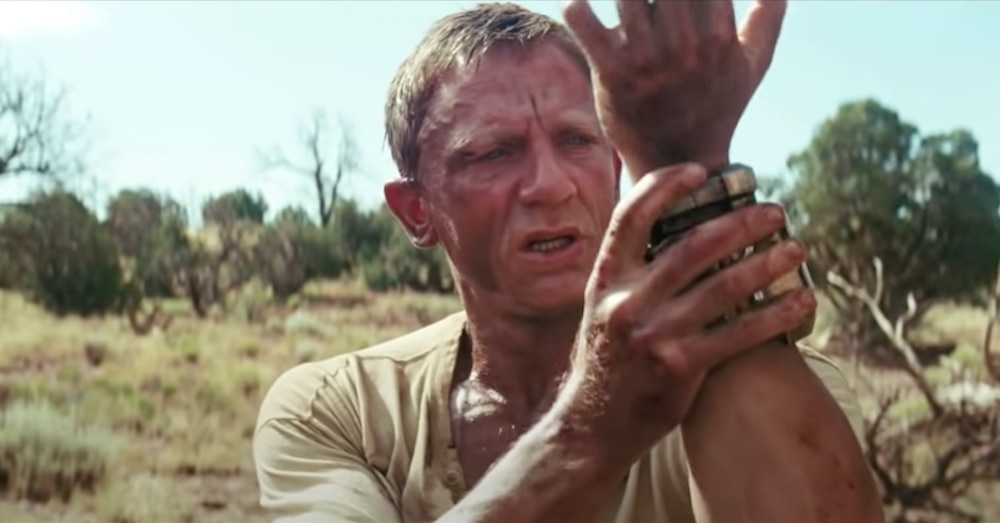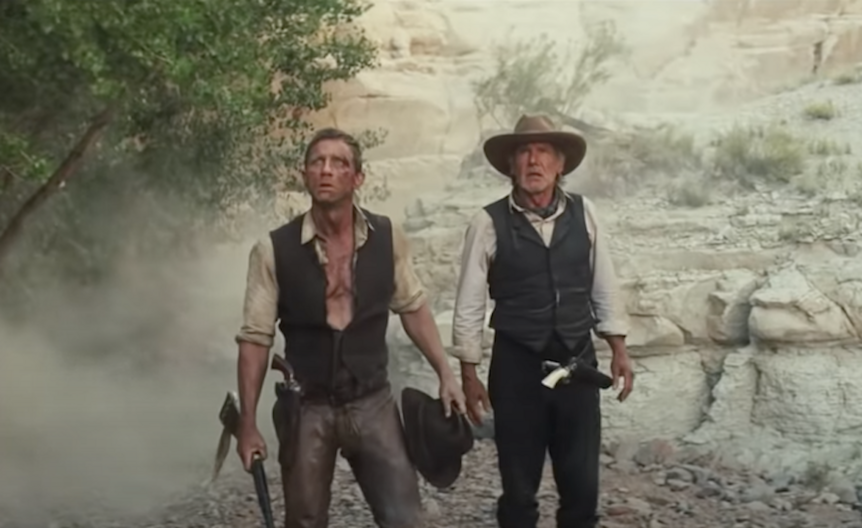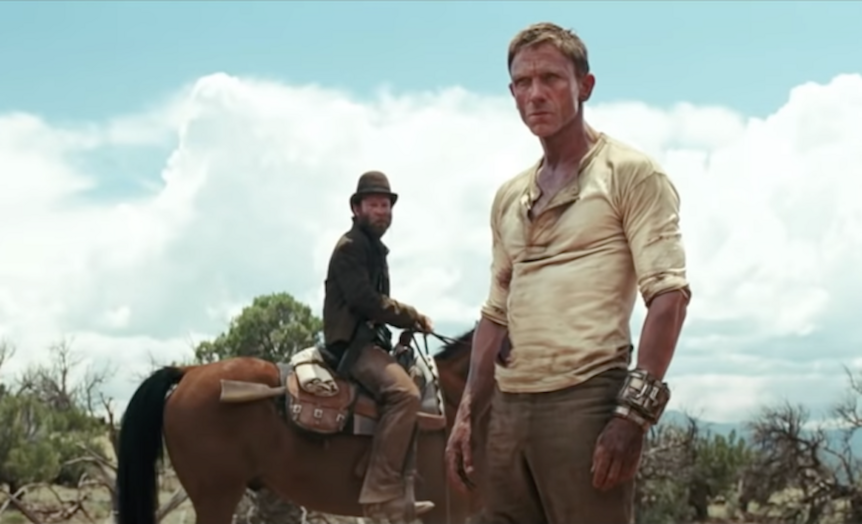Create a free profile to get unlimited access to exclusive videos, sweepstakes, and more!
Cowboys & Aliens Creators Look Back on Comic that Spawned Jon Favreau's Genre-Mashing Blockbuster
Cowboys & Aliens all began with an original idea from Platinum Studios founder, Scott Mitchell Rosenberg.

What makes a tale of two genres so appealing? What is it about the proposition of mashing together a pair of seemingly incongruous concepts that ramps up audience excitement?
If you do it right, the end result is "two great tastes that go great together," veteran comic book artist Dennis Calero (X-Factor, Legion of Super-Heroes) tells SYFY WIRE over Zoom. "It's two things that are familiar and comfortable." A prime example of that proverbial chocolate getting mixed into some proverbial peanut butter is Cowboys & Aliens (now streaming on Peacock!), the 2006 graphic novel published by Platinum Studios that led to the blockbuster film adaptation helmed by Iron Man director, Jon Favreau.
The comic was based on an original idea by Platinum Studios co-founder and CEO, Scott Mitchell Rosenberg, who hoped to recreate the success of Men in Back (the 1997 smash hit was based on a rather obscure comic book series published by Rosenberg's first company, Malibu Comics). To actualize Cowboys & Aliens into a physical product that could be shopped around to Hollywood studios as proof of concept for the feature-length treatment, Rosenberg tapped future Marvel writer, Fred Van Lente (Captain America: Homecoming, Deadpool & co.).
For More on Cowboys & Aliens:
Cowboys & Aliens Creator Scott Mitchell Rosenberg Dishes on Film Adaptation, Sequel Comic & Reboot Hopes
Revisiting Jon Favreau's ‘Cowboys & Aliens’ in a post-'Yellowstone' world
Here's how 'Cowboys & Aliens' was a key step on Jon Favreau's journey to creating 'The Mandalorian'
Cowboys & Aliens Comic Book Co-Creators Dennis Calero and Fred Van Lente Discuss Origins of Wild Genre Mash-Up
"That was, I believe, my first major paid comics gig," Van Lente tells SYFY WIRE during a phone conversation. "And this was like in 2001... I turned it in the day before I got married. My wife, and I just celebrated our 21st wedding anniversary, so that's how long ago it was. It’s a special place in my heart, just because it was the first time somebody paid me to write a comic ... I just thought it was a really neat concept. My initial draft brought that kind of Men in Black energy to it, in that it was fun and exciting and action-packed, but didn't take itself too seriously." Some of Van Lente's "Men in Black playfulness" was ultimately scaled back via a rewrite by Andrew Foley.
Calero was brought on board to draw the opening prologue, which draws a direct parallel between the white European colonizers and American frontiersmen who wrongfully encroached upon Native American land in the name of Manifest Destiny and the alien invaders. "I approached it more as an advertising or presentation job," Calero admits. "We were trying to get across certain images, certain ideas. I wanted someone to be able to just literally flip through the first few pages and go, ‘Okay, I got it. I see spaceships, I see cowboys, I see aliens. I get what the idea is, and we can move forward from there.’ So clarity was the biggest key."
He astutely points out that the comic's title itself is a meta-commentary on the troublesome history of the Western genre, particularly its tactless treatment of Indigenous Peoples.
"‘Cowboys and Indians’ is kind of a pejorative and reductive term, so this was a way — from a grammatical point of view, from a meta-textual point of view — to take something that was familiar and sort of passé, borderline offensive, and breathe new life into it and say, ‘Well, this is a different way we can look at this genre,’" the artist explains. "Take that Old West milieu and try to de-stigmatize it and still have it be high adventure without falling into the traps of the traditional Western. All our Westerns now, the ones I like anyway ... try to be sensitive to issues of Indigenous Americans and try to be more honest about our collective past as Americans. But this was a way to sort of bring the fun back into the genre [and do it] in a way that felt original and interesting."
He continues: "Because it was a science fiction thing, I partially took the advantage of using 3D models for the first time. I don't think a lot of people were doing that at the time. I was experimenting with bringing 3D models into Photoshop and playing with them and using them to different effect. When I was little, I would get these Jim Steranko and Jack Kirby comics, and in the middle of these [books], there were these giant photo montages and all this crazy stuff. I just thought that was really interesting to not necessarily be dogmatic about the approach to illustrating a book. [It] doesn’t have to all be drawing — it could be drawn with photographs, with graphics, with computer graphics."
Van Lente reveals that the original plan was to depict the titular extra-terrestrials as "Xenomorph-type aliens," with "more of a straightforward horror treatment." He decided to upend this notion based on the reasoning that a late 19th-century society wouldn't be able to hold its own against unstoppable killing machines from beyond the stars.
"A lot of my script was playing upon the idea that the aliens were this colonizing force, much in the same way the Europeans were colonizers on the North American continent. There were a lot more Native Americans in my comic, where they were able to find common ground on the basis of fighting this common foe," he says. "The settlers were moving into territory that the Native Americans were inhabiting, and they had to band together to fight this common alien force, which [is] really [what] the ending of Watchmen is all about. So I was really trying to carry on that tradition: different humans banding together in their dislike of murderous beings from outer space."
The writer also wanted to lean into the burgeoning sci-fi literature of the 1800s, which included Jules Verne's From the Earth to the Moon, H.G. Wells' War of the Worlds, and Edgar Allan Poe's "The Unparalleled Adventure of One Hans Pfaall." These stories dealt with concepts of space travel, alien beings, and, in the case of Verne's novel, flat-out predicted the necessary criteria for NASA's mission to the moon a little over a century later.
"I had arguments with Platinum. I think part of what was getting them stuck in the story was they were getting hung up on the idea that the cowboys would see the aliens as practicing witchcraft or [that] they were demons from Hell or something," Van Lente recalls. "And I'm like, ‘No, they had science in the 19th century.’ I pointed out all these things that folks were actually thinking about in the mid-19th century and [said], ‘No, I think they were actually pretty well familiar with the concept of beings from [outer space] ... It was all very much in the zeitgeist."
Universal Pictures and DreamWorks announced their intentions to bring Cowboys & Aliens to the silver screen in the latter half of 2007. The project arrived in theaters four years in late July of 2011 with Jon Favreau (fresh off the first two Iron Man adventures) sitting in the director's chair. The film also enjoyed input from producers Steven Spielberg and Ron Howard — a pair of industry titans who had long since proven their ability to occupy the cinematic realms of sci-fi and history. An absolutely stellar acting ensemble comprised of Daniel Craig, Harrison Ford, Olivia Wilde, Sam Rockwell, Paul Dano, Clancy Brown, and Walton Goggins rounded out the incredibly loose adaptation, which saw Craig playing amnesiac outlaw Jake Lonergan, who leads a small army of frontiersmen and Native Americans against gold-mining E.T.s.
"I felt that the movie carried a lot of the spirit of the book faithfully, even in changing details and shaping the narrative into a movie, which is not a comic book. That’s kind of the point," says Calero, going on to add that the very idea of committing comic books to film raises difficult questions about creator compensation.
"I have a friend — I'm not gonna say who it is or what the project was — but [they] basically told me recently, ‘I’m not mad at someone’ — I’m not gonna say who — ‘but it is difficult to watch a show and see concepts that I created whole cloth. I wrote them in, I drew them, I created them in a comic — and seeing those ideas writ large on the screen and I'm not even given a thank you.' ... There's a way to be a consumer and a fan that entails understanding your patronization of certain things [and] how those effects ripple out to the lives of real people. Whether you're buying a television or buying a book or seeing a movie, I think having it in the back of your mind [is important]. Is this company ethical? Do they try to treat people right? Do they seem to be constantly in fights with people? [Are they] trying to steal money from them or withhold what feels like should be it appropriate compensation? Let that inform your decision as to what you consume."
Why Didn't Cowboys & Aliens Get a Sequel?
Despite an all-star cast and crew working on both sides of the camera, Cowboys & Aliens failed to strike a major vein of box office gold, netting a little over $174 million globally against a costly production budget of $163 million. Middling to negative reactions from critics and audiences (the film's critical and audience ratings on Rotten Tomatoes currently stand at 44 and 43 percent, respectively) cemented the project as a frontier-sized failure. As Van Lente explains that at the time, the entertainment industry was wary of green-lighting sci-fi/Western mashups after the colossal bomb that was Barry Sonnenfeld's Wild Wild West almost two decades previously.
"They didn't lean into the fun of it," posits the writer. "This is back in the 'Dark Ages,' pre-the MCU really getting going. And so, a lot of Hollywood, I think, [was] — for lack of a better word — insecure about the public taking stuff that comes from comic seriously. I think that they just took too much fun out of it. It’s not a horror movie, it's not really a Men in Black-type, good-natured, family-friendly adventure film. Unfortunately, I don’t think it really knows what it wants to be. I love Galaxy Quest, which was much more of a straightforward comedy than Cowboys & Aliens, but I was like, ‘That's what you kind of need, this sense of adventure.’ I just think the movie has too many horror elements to it, and it begs the question of: ‘Why the Old West? Why does this particular story have to be told in this way?’"
While both the graphic novel and film adaptation do leave the door open for potential follow-ups, no big screen sequel was ever discussed. However, Van Lente does let slip that he's "heard rumblings from Scott over the years, but nothing that's literally come across my desk." Eight years after the release of Cowboys & Aliens, Favreau got a shot at redemption with The Mandalorian, which showed the director's ability to deftly balance a gritty sci-fi universe with the storytelling tropes of classic Westerns.
"Star Wars has always got one foot in [Akira] Kurosawa samurai movies and the other foot in those old-time Westerns," Van Lente concludes. "And obviously, Westerns were a huge influence on samurai movies."
In terms of a hypothetical Cowboys & Aliens reboot, Calero believes the property might work better as a television series, with the long-form narrative medium providing "more real estate" for the story to breathe.
"I think there could be something said about when cultures collide and there's a power imbalance that you could explore to great effect in a television show and start talking about some of these difficult topics," he muses. "There's the obvious comparison of the aliens encroaching ‘our land' when ‘we’ have encroached on the lands of Indigenous people. That was probably not wise to leave as subtext in a high fantasy adventure film, but this could be something that could be explored as text in a very interesting way in a show."
Cowboys & Aliens is now streaming on Peacock.
Originally published Aug 1, 2023.
















